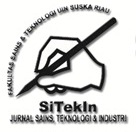Application of Fuzzy Time Series Method Cheng Model in Forecasting Stock Prices PT Bukit Asam Tbk
Abstract
Full Text:
PDFReferences
M. Pant, “Particle swarm optimization and intuitionistic fuzzy set-based novel method for fuzzy time series forecasting,” Granul. Comput., vol. 7, no. 2, pp. 285–303, 2022, doi: 10.1007/s41066-021-00265-3.
P. Melin, “Optimization using the firefly algorithm of ensemble neural networks with type-2 fuzzy integration for COVID-19 time series prediction,” Soft Comput., vol. 27, no. 6, pp. 3245–3282, 2023, doi: 10.1007/s00500-020-05549-5.
Y. Tang, “Building Trend Fuzzy Granulation-Based LSTM Recurrent Neural Network for Long-Term Time-Series Forecasting,” IEEE Trans. Fuzzy Syst., vol. 30, no. 6, pp. 1599–1613, 2022, doi: 10.1109/TFUZZ.2021.3062723.
E. Egrioglu, “Recurrent fuzzy time series functions approaches for forecasting,” Granul. Comput., vol. 7, no. 1, pp. 163–170, 2022, doi: 10.1007/s41066-021-00257-3.
H. Nasiri, “MFRFNN: Multi-Functional Recurrent Fuzzy Neural Network for Chaotic Time Series Prediction,” Neurocomputing, vol. 507, pp. 292–310, 2022, doi: 10.1016/j.neucom.2022.08.032.
N. Kumar, “A novel hybrid fuzzy time series model for prediction of COVID-19 infected cases and deaths in India,” ISA Trans., vol. 124, pp. 69–81, 2022, doi: 10.1016/j.isatra.2021.07.003.
V. M. S. Ardila, “Fuzzy Time Series Methods Applied to (In)Direct Short‐Term Photovoltaic Power Forecasting,” Energies, vol. 15, no. 3, 2022, doi: 10.3390/en15030845.
A. M. AlRassas, “Advance artificial time series forecasting model for oil production using neuro fuzzy-based slime mould algorithm,” J. Pet. Explor. Prod. Technol., vol. 12, no. 2, pp. 383–395, 2022, doi: 10.1007/s13202-021-01405-w.
A. Azizpour, “Simulation of time-series groundwater parameters using a hybrid metaheuristic neuro-fuzzy model,” Environ. Sci. Pollut. Res., vol. 29, no. 19, pp. 28414–28430, 2022, doi: 10.1007/s11356-021-17879-4.
Y. Wang, “Data-driven prediction method for characteristics of voltage sag based on fuzzy time series,” Int. J. Electr. Power Energy Syst., vol. 134, 2022, doi: 10.1016/j.ijepes.2021.107394.
P. D’Urso, “Spatial robust fuzzy clustering of COVID 19 time series based on B-splines,” Spat. Stat., vol. 49, 2022, doi: 10.1016/j.spasta.2021.100518.
S. Xian, “Improved seagull optimization algorithm of partition and XGBoost of prediction for fuzzy time series forecasting of COVID-19 daily confirmed,” Adv. Eng. Softw., vol. 173, 2022, doi: 10.1016/j.advengsoft.2022.103212.
H. Yang, “An oil imports dependence forecasting system based on fuzzy time series and multi-objective optimization algorithm: Case for China,” Knowledge-Based Syst., vol. 246, 2022, doi: 10.1016/j.knosys.2022.108687.
R. Cerqueti, “Weighted score-driven fuzzy clustering of time series with a financial application,” Expert Syst. Appl., vol. 198, 2022, doi: 10.1016/j.eswa.2022.116752.
J. Hu, “Weighted Kernel Fuzzy C-Means-Based Broad Learning Model for Time-Series Prediction of Carbon Efficiency in Iron Ore Sintering Process,” IEEE Trans. Cybern., vol. 52, no. 6, pp. 4751–4763, 2022, doi: 10.1109/TCYB.2020.3035800.
A. Rostami, “A fuzzy-based flood warning system using 19-year remote sensing time series data in the Google Earth Engine cloud platform,” Adv. Sp. Res., vol. 70, no. 5, pp. 1406–1428, 2022, doi: 10.1016/j.asr.2022.06.008.
Á. López-Oriona, “Quantile-based fuzzy clustering of multivariate time series in the frequency domain,” Fuzzy Sets Syst., vol. 443, pp. 115–154, 2022, doi: 10.1016/j.fss.2022.02.015.
S. Surono, “Optimization of Markov Weighted Fuzzy Time Series Forecasting Using Genetic Algorithm (GA) and Particle Swarm Optimization (PSO),” Emerg. Sci. J., vol. 6, no. 6, pp. 1375–1393, 2022, doi: 10.28991/ESJ-2022-06-06-010.
Á. López-Oriona, “Quantile-based fuzzy C-means clustering of multivariate time series: Robust techniques,” Int. J. Approx. Reason., vol. 150, pp. 55–82, 2022, doi: 10.1016/j.ijar.2022.07.010.
D. Zhang, “An Interpretable Station Delay Prediction Model Based on Graph Community Neural Network and Time-Series Fuzzy Decision Tree,” IEEE Trans. Fuzzy Syst., vol. 31, no. 2, pp. 421–433, 2023, doi: 10.1109/TFUZZ.2022.3181453.
S. N. Arslan, “A hybrid sigma-pi neural network for combined intuitionistic fuzzy time series prediction model,” Neural Comput. Appl., vol. 34, no. 15, pp. 12895–12917, 2022, doi: 10.1007/s00521-022-07138-z.
S. E. Rodrigues, “An approach for evolving neuro-fuzzy forecasting of time series based on parallel recursive singular spectrum analysis,” Fuzzy Sets Syst., vol. 443, pp. 1–29, 2022, doi: 10.1016/j.fss.2021.09.009.
F. Pohan, I. Saputra, and R. Tua, “Scheduling Preventive Maintenance to Determine Maintenance Actions on Screw Press Machine,” J. Ris. Ilmu Tek., vol. 1, no. 1, pp. 1–12, 2023.
I. N. Permadi and D. B. Nisa, “A Model Experiment Design Using the Taguchi Method: A Case Study Of Making Concrete Roof,” J. Ris. Ilmu Tek., vol. 1, no. 1, pp. 36–44, 2023.
G. Filhaq, S. Aprianto, and H. Alfianto, “Design of Smart Locker Door Using Quality Function Deployment Based on ATMega 2560 Microcontroller,” J. Ris. Ilmu Tek., vol. 1, no. 1, pp. 25–35, 2023.
T. M. Sari and W. Dini, “Risk Assessment and Mitigation Strategy in The Halal Broiler Supply Chain,” J. Ris. Ilmu Tek., vol. 1, no. 1, pp. 13–24, 2023.
DOI: http://dx.doi.org/10.24014/sitekin.v21i1.22910
Refbacks
- There are currently no refbacks.
Copyright (c) 2023 SITEKIN: Jurnal Sains, Teknologi dan Industri
 | Editorial Address: FAKULTAS SAINS DAN TEKNOLOGI UIN SULTAN SYARIF KASIM RIAU Kampus Raja Ali Haji Gedung Fakultas Sains & Teknologi UIN Suska Riau Jl.H.R.Soebrantas No.155 KM 18 Simpang Baru Panam, Pekanbaru 28293 © 2023 SITEKIN, ISSN 2407-0939 |
SITEKIN Journal Indexing:
Google Scholar | Garuda | Moraref | IndexCopernicus | SINTA

SITEKIN by http://ejournal.uin-suska.ac.id/index.php

.png)





